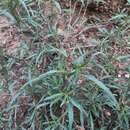Comments
provided by eFloras
The vernacular name "African amaranth" is sometimes used for this species; it is a misnomer; the species is native to South America and naturalized in Africa.
- license
- cc-by-nc-sa-3.0
- copyright
- Missouri Botanical Garden, 4344 Shaw Boulevard, St. Louis, MO, 63110 USA
Description
provided by eFloras
Plants annual or short-lived perennial, glabrous or slightly pubescent near tips. Stems ascending or prostrate, much-branched from stout rootstock, 0.1-0.4 m. Leaves: petiole to 1/2 as long as blade; blade linear to narrowly lanceolate, 1.5-8 × 0.2-0.5(-1) mm, base tapering, margins entire, plane to undulate, apex obtuse and often emarginate. Inflorescences terminal, compact pyramidal panicles and axillary glomerules, erect or reflexed, green, leafless at least distally. Bracts of pistillate flowers linear, 0.7-1.2 mm, 1/2-2/3 as long as tepals. Pistillate flowers: tepals 5, narrowly oblanceolate, not clawed, equal, 1.5-2 mm, apex obtuse or subacute; style branches erect; stigmas 3. Staminate flowers intermixed with pistillate or at tips of inflorescences; tepals 5; stamens 5. Utricles compressed, subglobose, 1.7-2 mm, ± equaling or slightly exceeding tepals, muricate, indehiscent. Seeds black, lenticular, 1-1.2 mm diam., semiglossy.
- license
- cc-by-nc-sa-3.0
- copyright
- Missouri Botanical Garden, 4344 Shaw Boulevard, St. Louis, MO, 63110 USA
Distribution
provided by eFloras
introduced; Ala.; s South America (Argentina, Paraguay, Uruguay); introduced in s Europe, s Africa, Australia, and other regions.
- license
- cc-by-nc-sa-3.0
- copyright
- Missouri Botanical Garden, 4344 Shaw Boulevard, St. Louis, MO, 63110 USA
Habitat
provided by eFloras
Waste places, on ballast; 0m.
- license
- cc-by-nc-sa-3.0
- copyright
- Missouri Botanical Garden, 4344 Shaw Boulevard, St. Louis, MO, 63110 USA
Synonym
provided by eFloras
Euxolus muricatus Moquin-Tandon in A. P. de Candolle and A. L. P. P. de Candolle, Prodr. 13(2): 276. 1849
- license
- cc-by-nc-sa-3.0
- copyright
- Missouri Botanical Garden, 4344 Shaw Boulevard, St. Louis, MO, 63110 USA
Comprehensive Description
provided by North American Flora
Amaranthus muricatus (Moq.) Gillies; (Moq. in DC. Prodr. 13 2 : 276, as synonym. 1849) Hicken, Apunt. Hist. Nat. 2: 92.
1910.
Euxolus muricatus Moq. in DC. Prodr. 13 2 : 276. 1849.
Stems slender, erect or ascending, flexuous, 3-7 dm. high, sulcate-striate, glabrous, much branched; petioles 5-15 mm. long; leaf-blades linear to oblong-linear, 2-8 cm. long, rounded at the apex, apiculate, attenuate at the base and decurrent, deep-green, glabrous; flowers monoecious, in dense, often interrupted, erect or drooping, paniculate spikes, these 1.5-6 cm. long; bracts broadly ovate, obtuse or acutish, shorter than the flowers; sepals 5, narrowly. oblong, obtuse or acutish, 1-nerved, mucronate, 1.75 mm. long; stamens 3; style-branches 3, short; utricle subglobose, about equaling the sepals, indehiscent, strongly rugosetuberculate; seed obovoid, 1.5 mm. long, dark reddish-brown or black, dull.
Typ:^ locality: Near Mendoza, Argentina.
Distribution: Argentina; adventive about Mobile, Alabama; adventive, also, in France and Spain.
- bibliographic citation
- Paul Carpenter Standley. 1917. (CHENOPODIALES); AMARANTHACEAE. North American flora. vol 21(2). New York Botanical Garden, New York, NY
Amaranthus muricatus: Brief Summary
provided by wikipedia EN
Amaranthus muricatus, the so-called African amaranth, is a species in the genus Amaranthus native to South America; Bolivia, Paraguay, Argentina and Uruguay. It is an invasive species in Africa, Europe and Australia, and to a lesser degree in North America and Asia. It is a decumbent perennial that does well in arid climates.
A. muricatus may grow to about 60 cm tall. Its glabrous leaves are linear to lanceolate, about 2-5 cm long, with long petioles. Small flowers are produced on compact, pyramidal panicles. These flowers, which appear in summer and fall, produce wrinkled achenes, about 2 mm long, containing semiglossy, black, lenticular seeds that are typically 1-1.2 mm in diameter.
- license
- cc-by-sa-3.0
- copyright
- Wikipedia authors and editors

